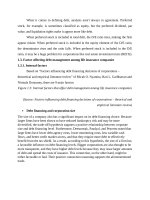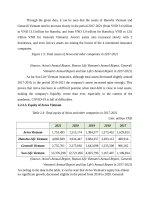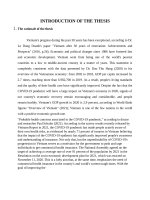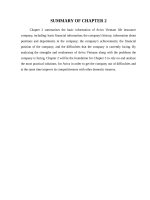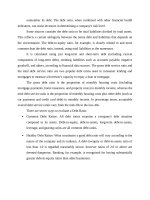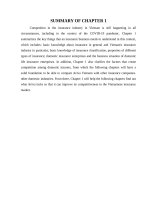What i have studied from school 0018
Bạn đang xem bản rút gọn của tài liệu. Xem và tải ngay bản đầy đủ của tài liệu tại đây (23.23 KB, 1 trang )
1.2.5. Debt-to-equity ratio
The debt-to-equity (D/E) ratio is computed by dividing a company's total liabilities
by its shareholder equity to determine its financial leverage. In corporate finance, the D/E
ratio is a crucial measure. It's a measure of how much a company relies on debt to fund
its operations rather than wholly owned funds. In the case of a corporate downturn, it
indicates the capacity of shareholder equity to satisfy all existing obligations. A specific
sort of gearing ratio is the debt-to-equity ratio.
The debt-to-equity ratio of a corporation is calculated using the following formula:
The D/E ratio requires information from a company's financial sheet. Total
shareholder equity must equal assets minus liabilities on the balance sheet, which is a
rearranged form of the balance sheet equation:
Individual accounts that would not ordinarily be deemed "debt" or "equity" in the
traditional sense of a loan or the book value of an asset may be included in these balance
sheet categories. Because retained earnings/losses, intangible assets, and pension plan
modifications can affect the ratio, more investigation is typically required to determine a
company's real leverage. Analysts and investors frequently change the D/E ratio to make
it more helpful and simpler to compare various stocks due to the uncertainty of some of
the accounts in the key balance sheet categories. Short-term leverage ratios, profit
performance, and growth projections may all help enhance the D/E ratio analysis.
Because the D/E ratio compares the amount of a firm's debt to the value of its net
assets, it's commonly used to determine how much debt a company is taking on to
leverage its assets. A high D/E ratio is frequently linked with high risk; it indicates that a
corporation has used debt to fund its expansion.
When a lot of debt is utilized to fund expansion, a firm may be able to make greater
earnings than it would have been able to without it. Shareholders should expect to profit
if
